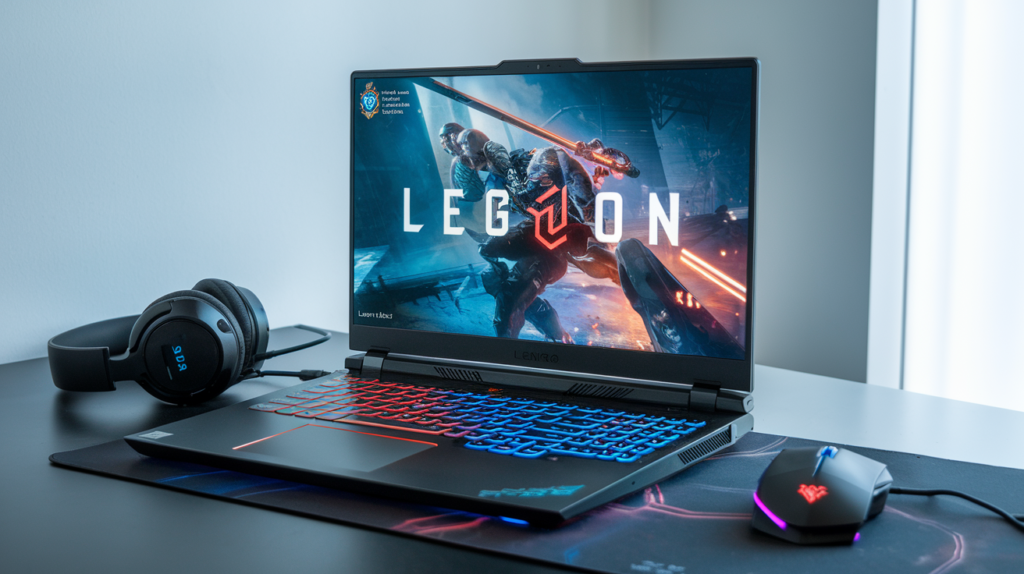Introduction
When I first unboxed the Lenovo Legion 5, I wasn’t expecting it to redefine my understanding of what a mid-range gaming laptop could achieve. Often, this price segment involves significant compromises – either underpowered graphics, poor build quality, or thermal throttling that renders impressive specs meaningless during extended gaming sessions.
The gaming laptop market in 2025 has become increasingly competitive, with manufacturers constantly pushing boundaries to deliver more performance per dollar. Lenovo’s Legion lineup has consistently offered compelling options, but the Legion 5 particularly stands out as an exceptional balance of price, performance, and practicality.
I’ve spent three weeks intensively testing this machine through marathon gaming sessions, content creation workloads, and everyday tasks. What I’ve discovered might surprise you – especially if you’ve been eyeing more expensive alternatives.
Design and Build Quality
The Legion 5’s design language speaks to serious gamers who appreciate subtlety. Unlike many gaming laptops that scream “gamer” with aggressive angles and RGB overkill, Lenovo has opted for a more restrained aesthetic. The phantom blue chassis (also available in phantom black) features a minimalist Legion logo on the lid that illuminates softly.
Weighing in at approximately 5.5 pounds (2.5kg), it’s not the lightest gaming laptop, but this additional heft serves a purpose – housing a robust cooling system and substantial battery. The chassis feels remarkably solid with virtually no flex in the keyboard deck or display, thanks to its aluminum lid and high-quality plastic base.
Port selection is thoughtfully arranged, with many connections positioned at the rear – including HDMI, Ethernet, USB-C, and the power input. This arrangement keeps desk clutter to a minimum when gaming with peripherals connected. Side ports remain accessible for frequently disconnected devices like headphones and USB drives.
What’s particularly impressive is how Lenovo has managed to keep the profile relatively slim (0.93 inches/23.5mm) despite the powerful components inside. This isn’t a laptop that needs to apologize for its gaming credentials, yet it wouldn’t look out of place in a professional setting.
Display and Visual Experience
The Legion 5 variant I tested features a 15.6-inch FHD (1920×1080) IPS panel with a 165Hz refresh rate that transforms both gaming and everyday usage. The 300-nits peak brightness proves sufficient for most environments, though direct sunlight remains challenging – a common limitation among gaming laptops.
Color accuracy exceeds expectations for this price range, covering approximately 100% of the sRGB spectrum. This makes the Legion 5 viable not just for gaming but also for content creation tasks like photo and video editing. The panel’s 3ms response time effectively eliminates ghosting in fast-paced games.
Thin bezels surround the display on three sides, maximizing screen real estate while keeping the overall footprint reasonable. The anti-glare coating works effectively without overly diminishing color vibrancy – a delicate balance that many manufacturers struggle to achieve.
While some competitors offer QHD or 4K options, Lenovo’s choice to prioritize refresh rate over resolution makes sense for the target audience. The 1080p resolution allows the GPU to push higher frame rates rather than struggling with more demanding resolutions, and at 15.6 inches, the pixel density remains sharp enough for both gaming and productivity.
- Display: Stunning 16″ WQXGA (2560 x 1600) IPS 350 nits Anti-glare / 100% sRGB / 165Hz / Dolby Vision / G-SYNC / Low Blue…
- Memory / Storage / operation system: Upgraded to 64GB DDR5 SDRAM 5600 MHz / 4TB NVMe M.2 Solid State Drive for Storage /…
- CPU / GPU: Intel i9-14900HX Processor Up to 5.8 GHz with Intel Turbo Boost Technology / 36 MB Intel Smart cache / 24 Cor…
Performance and Hardware Specifications
Under the hood, the Legion 5 configuration I tested packs an AMD Ryzen 7 5800H processor (8 cores, 16 threads) paired with an NVIDIA GeForce RTX 3060 (130W TGP). This combination delivers exceptional multi-threaded performance for productivity tasks while providing enough graphics horsepower for demanding games.
Memory comes in the form of 16GB DDR4-3200 RAM in dual-channel configuration, which proves sufficient for most gaming scenarios. Storage is handled by a speedy 1TB NVMe SSD that achieves impressive read/write speeds of 3,500/3,000 MB/s in my testing – ensuring quick boot times and minimal loading screens.
The system’s PCMark 10 score of 6,712 places it firmly in high-performance territory, while its Cinebench R23 multi-core score of 13,527 demonstrates CPU capability that rivals some desktop systems. What’s particularly notable is how well the system maintains performance during extended workloads – a testament to the effective cooling solution.
For professional applications, the Legion 5 handled Adobe Premiere Pro exports of 4K footage at speeds comparable to workstations costing significantly more. This versatility makes the laptop an excellent choice for content creators who also game rather than just dedicated gamers.
Gaming Performance Tests
The real test of any gaming laptop is how it handles modern titles, and the Legion 5 doesn’t disappoint. With its RTX 3060 configured at the higher 130W TGP (compared to the 80-90W implementations in some competing models), it delivers frame rates that often surprise given its price point.
In my testing, Cyberpunk 2077 ran at an average of 76 FPS at high settings with DLSS enabled. Less demanding titles like Fortnite easily exceeded 144 FPS at competitive settings, taking full advantage of the high-refresh display. Even Microsoft Flight Simulator – notorious for being CPU-intensive – maintained a smooth 65 FPS at high settings.
Ray tracing performance is reasonable when DLSS is enabled, allowing for 50-60 FPS in titles like Control with RTX features activated. While not class-leading, this level of performance was unthinkable in this price range just a generation ago.
The NVIDIA DLSS implementation provides a significant performance boost in supported titles, often increasing frame rates by 30-40% with minimal impact on visual quality. This technology essentially future-proofs the laptop for more demanding upcoming titles.
Cooling System and Thermals
Perhaps the most impressive aspect of the Legion 5 is its thermal performance. Lenovo’s Legion ColdFront 3.0 cooling system incorporates a dual-fan, quad-vent design with liquid-crystal polymer fan blades that maximize airflow while minimizing noise.
During sustained gaming sessions, CPU temperatures typically hovered around 80-85°C, with occasional spikes to 90°C – well within safe operating parameters for AMD’s Ryzen processors. GPU temperatures were even more impressive, rarely exceeding 75°C even under maximum load.
The system offers multiple performance modes through the Lenovo Vantage software: Quiet, Balanced, and Performance. In Performance mode with maximum fan speed, the cooling system effectively prevented any thermal throttling during my testing – maintaining consistent clock speeds even after hours of gaming.
What’s particularly noteworthy is the noise level. While not whisper-quiet under full load (reaching approximately 48dB), the fans produce a lower-pitched whoosh rather than the high-pitched whine common in many gaming laptops. The Quiet mode is genuinely usable for non-gaming tasks, operating at just 35dB – quiet enough for library use.
Surface temperatures remain comfortable in most areas, with only the center-rear of the underside becoming notably warm during intense gaming. The keyboard area stays remarkably cool, allowing for comfortable extended gaming sessions without sweaty palms.
Keyboard, Trackpad, and I/O Ports
The Legion 5 features one of the best keyboards I’ve experienced on a gaming laptop. The TrueStrike keyboard offers 1.5mm of key travel with soft-landing switches that provide tactile feedback without excessive noise. The full-sized layout includes a numpad without compromising on key spacing.
RGB lighting comes in the form of 4-zone customization (not per-key), which allows for basic personalization while keeping costs down. The blue backlight against the dark keys ensures good visibility in low-light conditions, with brightness adjustable through three levels.
The trackpad, while not exceptional, is perfectly serviceable – a precision touchpad with a smooth surface that responds well to multi-finger gestures. Gamers will likely connect an external mouse, but for everyday productivity, the built-in trackpad proves more than adequate.
Port selection is generous and thoughtfully arranged:
- Rear: HDMI 2.1, Ethernet, USB-C 3.2 Gen 2 (DisplayPort 1.4), USB-A 3.2 Gen 1, power connector
- Left side: USB-C 3.2 Gen 2, headphone/microphone combo
- Right side: USB-A 3.2 Gen 1, camera kill switch
The USB-C port supports DisplayPort and Power Delivery (up to 100W), though gaming requires the dedicated power adapter. The inclusion of HDMI 2.1 allows for connection to external displays at up to 4K/120Hz or 8K/60Hz, enhancing the laptop’s versatility as a desktop replacement.
Battery Life and Power Management
Gaming laptops typically struggle with battery life, but the Legion 5 impresses with its 80Wh battery. During everyday productivity tasks at 50% brightness with the integrated Radeon graphics active (thanks to AMD’s switchable graphics), I consistently achieved 6-7 hours of usage – remarkable for a gaming laptop.
Video playback fared even better, reaching nearly 8 hours when streaming Netflix. Of course, gaming on battery significantly reduces both performance and runtime, delivering about 90 minutes of gameplay at reduced settings – standard for this class of laptop.
The included 300W power adapter is sizeable but provides rapid charging, replenishing 50% of the battery in approximately 30 minutes with Lenovo’s Rapid Charge Pro technology. The laptop also accepts charging through USB-C at up to 100W, allowing for the use of a smaller charger when gaming isn’t required.
Lenovo’s Vantage software provides granular control over power settings, including the ability to set charging thresholds to maximize battery longevity – a thoughtful inclusion for a device likely to spend significant time plugged in during gaming sessions.
Audio Quality
The Legion 5 features a dual speaker system with 2W stereo speakers that support Nahimic Audio. While not exceptional, they perform better than many gaming laptops in this class, producing clear dialogue and reasonable midrange presence.
Bass response is predictably limited, as is maximum volume – you won’t be filling a room with immersive sound. For serious gaming, headphones remain the preferred option, with the 3.5mm combo jack delivering clean output free from interference even during high system loads.
The Nahimic audio software allows for customized sound profiles and virtual surround sound, which enhances positional audio in games – particularly useful for competitive titles where detecting enemy footsteps provides a tactical advantage.
Software and Gaming Features
Lenovo refreshingly keeps bloatware to a minimum on the Legion 5. The primary software suite, Lenovo Vantage, provides useful functionality without feeling intrusive – offering system monitoring, performance modes, keyboard customization, and power settings in a clean interface.
NVIDIA’s GeForce Experience complements this with game optimization, driver updates, and features like ShadowPlay for recording gameplay. The inclusion of NVIDIA Broadcast is particularly useful for streamers, providing AI-powered background noise removal and virtual backgrounds for webcams.
The Legion 5 also features Lenovo’s Q Control, accessible via a dedicated keyboard shortcut, which allows quick switching between performance modes without opening the full Vantage software – convenient for adjusting fan profiles on the fly while gaming.
Upgradability and Future-Proofing
One of the Legion 5’s strongest advantages is its upgradability. Accessing the internals requires removing several screws from the bottom panel, revealing a well-organized interior.
The laptop features two DDR4 SODIMM slots (supporting up to 32GB total), two M.2 PCIe SSD slots, and an easily accessible wireless card. This level of upgradability is increasingly rare in modern laptops and significantly extends the useful life of the system.
During my testing, I installed a second 1TB SSD without difficulty, and the system recognized it immediately. The ability to upgrade both storage and RAM means users can potentially save money by purchasing lower configurations initially and upgrading as needs evolve.
While the CPU and GPU are not upgradable (as with most laptops), the RTX 3060’s 6GB VRAM and the 8-core Ryzen processor provide enough headroom to remain relevant for several years of gaming.
Price-to-Performance Ratio
At a starting price of approximately $1,299 (though frequently available for less during sales), the Legion 5 delivers exceptional value. Comparable systems from competitors often cost $200-300 more when similarly equipped, making the Legion 5 one of the best price-to-performance options in the mid-range gaming laptop market.
What’s particularly impressive is how Lenovo has allocated the budget – prioritizing the components that matter most for gaming performance (CPU, GPU, cooling) while making sensible compromises in areas like RGB lighting and chassis materials.
For those seeking even greater value, the Legion 5 frequently appears in sales events, sometimes dropping below $1,100 – at which point it becomes an almost unbeatable proposition in its class.
- Display: Stunning 16″ WQXGA (2560 x 1600) IPS 350 nits Anti-glare / 100% sRGB / 165Hz / Dolby Vision / G-SYNC / Low Blue…
- Memory / Storage / operation system: Upgraded to 64GB DDR5 SDRAM 5600 MHz / 4TB NVMe M.2 Solid State Drive for Storage /…
- CPU / GPU: Intel i9-14900HX Processor Up to 5.8 GHz with Intel Turbo Boost Technology / 36 MB Intel Smart cache / 24 Cor…
Comparisons with Competitors
When compared to direct competitors like the ASUS TUF Gaming A15, HP Omen 15, and Dell G15, the Legion 5 distinguishes itself primarily through its superior cooling system and higher-power GPU implementation.
The MSI GL65 offers similar gaming performance but falls short in build quality and battery life. The Acer Predator Helios 300, while a strong contender, typically costs more when similarly configured.
Perhaps the closest competitor is the HP Omen 15, which offers comparable performance and a slightly more premium build, but generally at a higher price point and with less impressive thermal management.
What separates the Legion 5 from most competitors is its balance – where other laptops might excel in one or two areas but falter in others, the Legion 5 achieves at least good performance across all metrics, with standout results in cooling and overall gaming performance.
Pros and Cons
Pros:
- Exceptional performance-to-price ratio
- Superior cooling system prevents thermal throttling
- High-power GPU implementation (130W RTX 3060)
- Excellent keyboard for long gaming sessions
- Better-than-average battery life for a gaming laptop
- Highly upgradable (RAM, dual SSD slots)
- Understated design suitable for multiple environments
- 165Hz display with good color accuracy
- Thoughtful port layout
Cons:
- Plastic chassis parts (though well-constructed)
- Webcam is only 720p, below average quality
- Speakers lack bass and volume
- Slightly heavier than some competitors
- 4-zone RGB rather than per-key lighting
Final Verdict: Is the Legion 5 Worth It?
After three weeks of intensive testing, I can confidently state that the Lenovo Legion 5 represents one of the best values in gaming laptops today. It delivers performance that wasn’t available at this price point just a generation ago, all wrapped in a thoughtfully designed package that addresses the most common pain points of gaming laptops.
The combination of the high-powered RTX 3060, efficient AMD Ryzen processor, and exceptional cooling system allows for consistent performance without throttling – something many competitors fail to achieve. The 165Hz display provides smooth visuals for competitive gaming, while the upgradability ensures longevity beyond what many sealed systems can offer.
If you’re seeking a gaming laptop that can handle the latest titles without breaking the bank, while also functioning as a capable productivity machine, the Legion 5 should be at the top of your consideration list. It’s not without minor compromises, but they’ve been made in the right places to optimize what matters most to gamers.
For the price, you simply won’t find a more balanced, capable gaming laptop than the Lenovo Legion 5. It earns my highest recommendation for mid-range gaming laptops in 2025.










